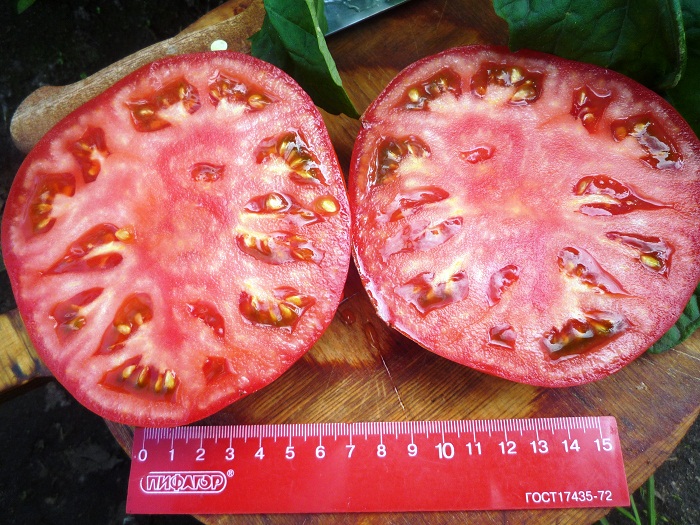 Beef group tomatoes were loved by gardeners, while in Russia, varieties of foreign selection are also successfully grown. The tomato variety Big Carol, which "came" to us from the USA, took root in many areas.
Beef group tomatoes were loved by gardeners, while in Russia, varieties of foreign selection are also successfully grown. The tomato variety Big Carol, which "came" to us from the USA, took root in many areas.
Content
Grade description
Such varieties are valued for large fruits, their unusual taste is sweet, with aroma, as well as fleshy and juicy pulp. Making a salad for a family from one such tomato is not a problem, and the vegetable really can be called a real delicacy.
Big Carol variety has different names in the catalogs - Carol Big Pasta, Carol Chyko’s Big Paste, so you need to be careful. It is believed that this unique tomato beef was bred by American breeders and is the pride of the Carol Chyko family (Pennsylvania). By terms, the variety is declared mid-season, but in a number of regions, judging by the reviews, it began to bear fruit later than 115 days later.
His bush is very powerful, grows up to two meters. It is recommended to grow a tomato in a greenhouse, with mandatory bush formation and pinching. Leaves of normal shape, color - dark green. Lateral shoots grow quickly, so stepsons must be removed in a timely manner.
A bush is formed in 1-2 stems, given this when planting plants in a greenhouse. Scheme - no more than three plants per square meter, and when grown in two stems, you can plant two bushes. In this case, the plants will have enough lighting and nutrition.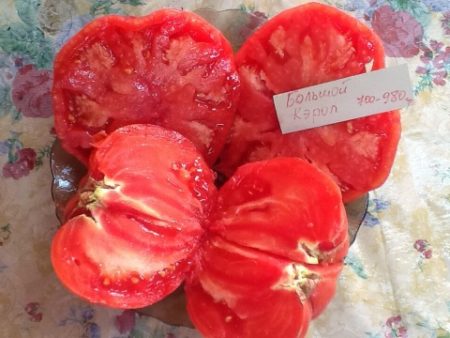
The brush begins to be tied after 9 sheets, the stepson under the first brush is used as the second stem. Tomato is resistant to disease, but phytophthora prevention is required.
Fruit Description
In beef tomato varieties, the fruits are usually large, and Big Carol is no exception. These tomatoes with good care grow up to about 400 grams, in the brush all the fruits are even.
The skin color is dark, burgundy, saturated color. The fruits look very beautiful in the green of the bush, attracting attention.
The pulp is juicy, fleshy, up to 4-6 small chambers are formed inside. Taste - balanced, bright, with refreshing notes, sweet. There are very few seeds, everything is “occupied” with pulp. The variety is unique, because even under adverse conditions gives excellent yields.
Tomatoes are used in salads, in processing (juices, sauces, pasta). All Carol Chyko’s Big Paste products have a very rich flavor and a beautiful tomato color. Shelf life of tomatoes of this variety is average, it is advisable to use the fruits for processing or to eat immediately after full ripening.
Advantages and disadvantages of the Big Carol tomato variety
The main advantage of such tomatoes is their weight and fleshy juicy pulp. The taste of litter is excellent, while it is quite resistant to weather conditions.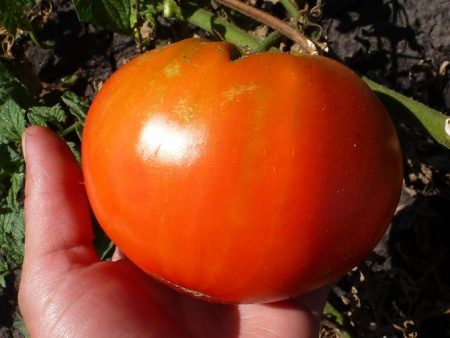
Advantages:
- large fruits (400-450 grams);
- pleasant sweet taste of tomatoes;
- high commercial properties of fruits;
- disease resistance.
American tomato is a variety, so it’s enough to write its seeds from collectors only once, and in the future to collect seeds from its plantings.
But in order to grow such a tasty and large tomato, you have to work hard. The variety needs plant formation, obligatory pinching.
Tomato Big Carol has a peculiarity: disposition to terry (fasciation) of flowers, and this must be taken into account.To obtain large tomatoes, it is recommended to pluck the flowers in the brush, leaving 2-3 pieces. Large tomatoes are usually formed from deformed inflorescences, while their shape may be slightly clumsy. To remove or leave such inflorescences - the gardener decides. It is believed that most often double flowers appear in the first brush and can inhibit the development of other fruits. Therefore, double flowers can be removed.
Also, this tomato requires good nutrition, good care, so for inexperienced gardeners it is better to choose other varieties of tomatoes, or pay enough attention to Big Carol.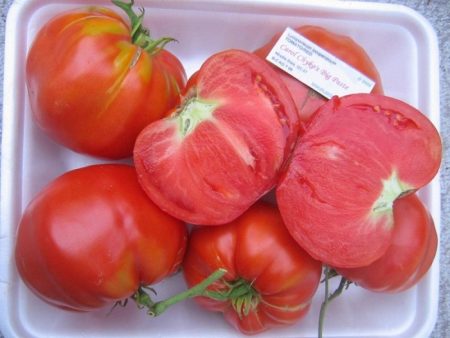
Tomato Growing Reviews
Marina, Irkutsk region
I have long wanted to prescribe beef tomatoes for myself, finally - the dream came true! Three varieties grew in the greenhouse last year, including Big Carol. The bush was tall, powerful, few brushes. Tomatoes are large, but to be honest, neither color nor taste impressed me. Maybe she was doing something wrong, but they didn’t like the pulp at all, the usual tomato, which I grow and have a lot in OG. Refused this grade.
Galina, Kemerovo
The variety is a fairy tale! I was struck by high productivity, taste. This is a tall tomato, in my greenhouse the height was about 180 cm. The fruits are round, with a hint of a heart-shaped shape, but they did not reach it. The color of the fruit, when fully ripe, was dark dark red, by weight - almost all about 400 grams. The pulp is juicy, there are practically no seeds inside the tomato. The taste is wonderful, in salads it goes with a bang, and we still love sandwiches with tomatoes, so Carol is perfect for them. Very fruitful tomato, collected seeds, this year is growing again.
Features agricultural technology tomato Big Carol
Since this variety belongs to large-fruited, it is necessary to take into account the specifics of the cultivation of such tomatoes.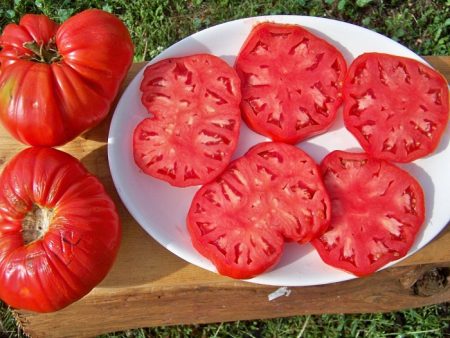
- When planting, strictly observe the layout of the bushes, planting them less often than ordinary varieties, 2-3 plants per 1 square. meter.
- Such varieties require enhanced top dressing, since a plant needs a lot of strength to form and ripen fruit.
- Fertilizer doses should be observed (“a lot doesn’t mean good”) when controlling the amount of nitrogen. With an overabundance of this element, the plants begin to “fatten”, the bushes are stretching, the lateral shoots are growing, and fruit production is deteriorating.
- Both the plants themselves and the brushes form, leaving a limited number of flowers in them. At the Big Carol variety, it is recommended to leave 2-3 flowers in the inflorescence, otherwise the tomatoes will be small, uneven or there will be no knotting at all.
Growing seedlings
This variety is sown with seeds in early March, so that by the time of planting the seedlings are about 60 days old. It is recommended to think over the illumination of plants, for which fluorescent lamps or LEDs are used.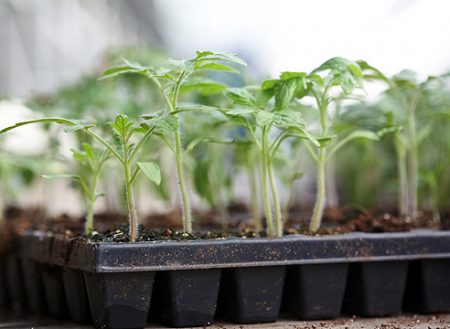
Seeds are pickled before sowing in a solution of potassium permanganate (incubated for no more than 20 minutes), then they must be washed. If there are growth stimulants in stock - EPIN, ENERGEN, you can soak tomato seeds in them, or you can immediately put the seeds in a moist tissue for germination. If the sowing day is selected according to the Lunar calendar, then it must be taken into account that the soaking or germination of tomatoes is considered the beginning of the sowing.
For seedlings, boxes, containers, pots of peat, as well as cups made of plastic or thick paper, are suitable. Sowing immediately in separate containers eliminates diving, but if seeds are sown in common boxes, picking is mandatory.
Feeding is carried out twice, after waiting for a dive for about 10 days. As fertilizers, it is best to use complex formulations, as well as ready-made water-soluble fertilizers.
A necessary condition for obtaining high-quality seedlings is a stable temperature regime (+ 23ºC ... + 25ºC), regular and moderate watering, and ventilation. Before planting in a greenhouse, tomatoes are recommended to be hardened, for which they are taken out to fresh air.
Greenhouse care
Landing is carried out only when stable, warm weather is established, taking into account the particular climate of the region. In the middle lane in the greenhouse, tomatoes can be identified already in early May, in the northern regions, as well as beyond the Urals - in late May or even in early June.
Bushes are planted, observing the distance, since large-fruited beef tomatoes love freedom and space.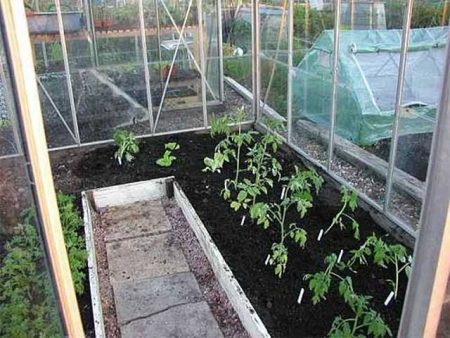
Soils fill up in the fall, introducing humus, superphosphate. When digging in the spring, add wood ash, bone meal, excluding fresh manure or bird droppings.
Big Carol is a variety that needs to be properly shaped. Indeterminate varieties of tomatoes are grown in 1-2 stems, since in this case it is more likely to grow large fruits.
If the plant is led into one trunk, then all side shoots are removed, and then all stepsons are regularly removed. When maintaining a bush in two stems, the largest powerful and tall stepson is left under the first flower brush. It will be the second trunk; inflorescences and fruits will form on it.
This variety is required to stepchild, otherwise in a greenhouse a tomato will grow strongly to the detriment of fruit formation. The procedure is carried out in the morning, about 1-2 times a week. Side shoots are removed, not allowing them to reach them a large length (about 5-6 cm), leaving a stump of one and a half centimeters. It’s best to choose the time in the morning so that the breaks on the branches last until the evening and that viruses do not get into them.
High bush grades of Big Carol need to be tied up. It is effective to use trellis, but ordinary stakes with fabric ribbons are quite suitable. Twine, wire for tying it is better not to use, as they can cut the stems and branches of tomatoes.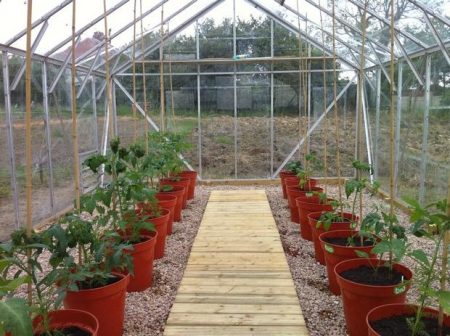
Another mandatory technique is the proper organization of watering, otherwise you will not get juicy and fleshy fruits. There is an opinion that tomatoes need rare but plentiful watering. All is correct, but at the same time it is necessary to consider:
- microclimate in the greenhouse;
- soil condition;
- the condition of the plants themselves;
- weather.
In hot weather, you will have to water more often, and after that - ventilate the greenhouse, opening the windows and doors. In cloudy weather, they are watered no more than 1-2 times a week, controlling the humidity level inside the shelters.
Tomatoes do not need excessive humidity, intense heat, since all this negatively affects the growth of culture, fruit formation. In dry air, tomato pollination does not occur in the greenhouse (pollen becomes sterile), with elevated humidity indicators the pollen becomes heavy and does not spill out.
The optimum moisture content is not more than 60%.
To improve the microclimate, it is recommended to mulch the soil in the greenhouse. Mulch can serve:
- sawdust;
- humus;
- peat;
- mowed grass.
Such materials not only provide the necessary moisture in the soil, but also eliminate weeds.
Particular attention is paid to top dressing of tomato. During the season, the plants are “fed” 4-5 times, alternating organics, mineral fertilizers, feeding under the root and foliage. Such a schedule will allow you to get high-quality large fruits with good taste.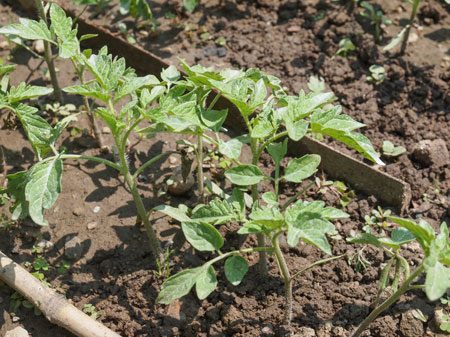
Birds, mullein (they are bred with water), complex compounds, wood ash are introduced as fertilizers. A very good top dressing is infusion prepared on the grass (dandelion, nettle, comfrey, other weed herbs growing in the garden). Such a green “cocktail” is insisted for a week, and then diluted with water (1:10) and watered tomatoes under the root.
From folk remedies for top dressing, baker's yeast, spraying tomatoes with iodine, boric acid showed good results.
Since the timing of fruit ripening in Big Carol is not early, you will have to take care of the prophylaxis for this tomato.
You can spray the plants with such compounds:
- garlic infusion;
- copper-containing preparations;
- Bordeaux liquid;
- ash infusion.
In mid-August, all upper flowering brushes are removed so that the lower fruits have time to form normally. The top is also pinched, and those ovaries that did not have time to form are removed.
Judging by the reviews, despite mid-ripening and later ripening, the Big Carol tomato variety is little susceptible to late blight. But in order not to take risks, when cold weather sets in, it is recommended to remove all green fruits so that they ripen at home. To get their own seeds for sowing on a bush, the most beautiful fruit is selected and left to ripen on the plant.
In general, fruits can be harvested as they reach technical maturity (i.e. green). They ripen well at home, I get a dark crimson color characteristic of the variety.




 Low-growing tomatoes, without pinching: 5 of the most delicious varieties
Low-growing tomatoes, without pinching: 5 of the most delicious varieties Why tomato seedlings grow poorly
Why tomato seedlings grow poorly We grow a tomato in a shell
We grow a tomato in a shell Growing tomatoes without watering according to the method of Kazarin
Growing tomatoes without watering according to the method of Kazarin